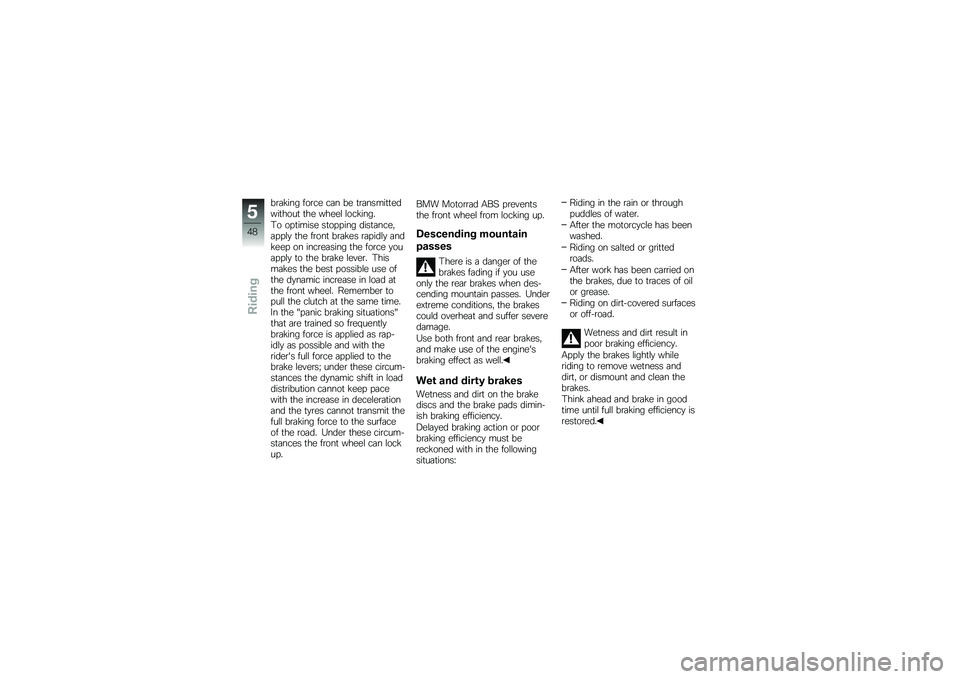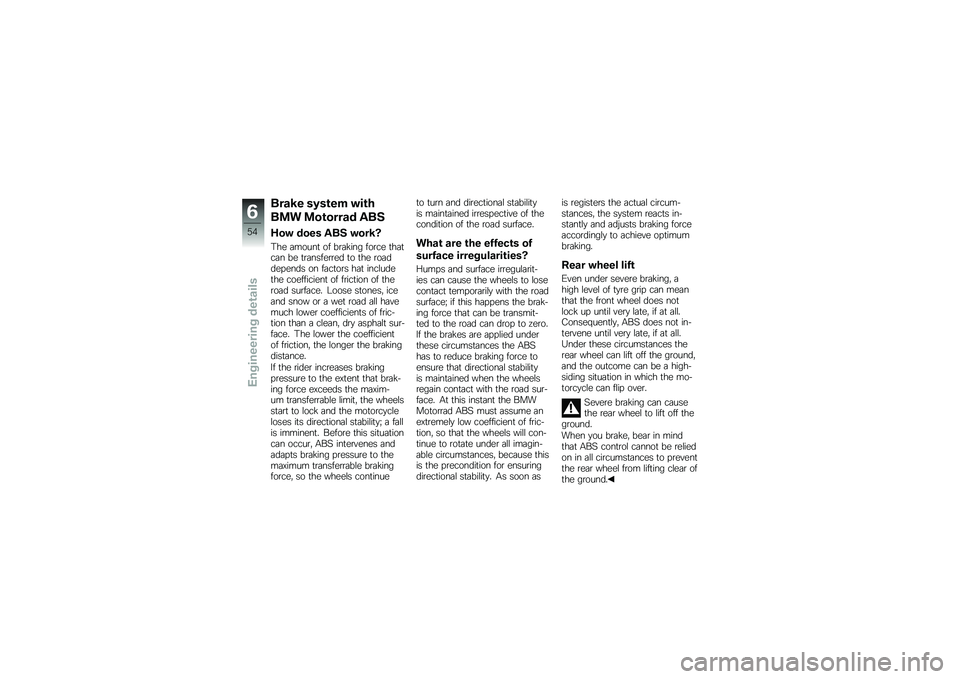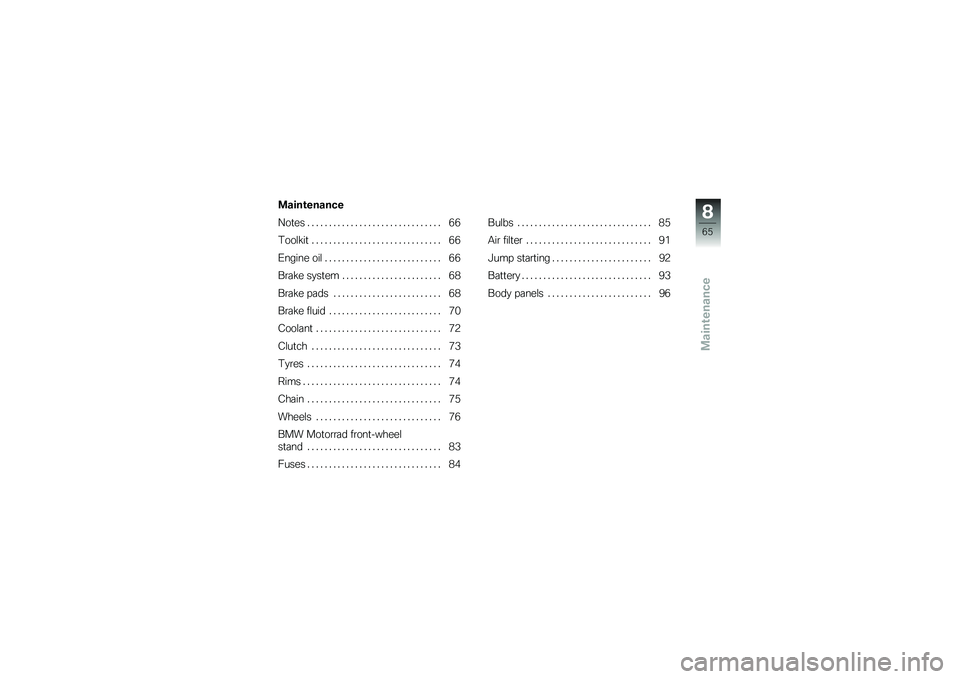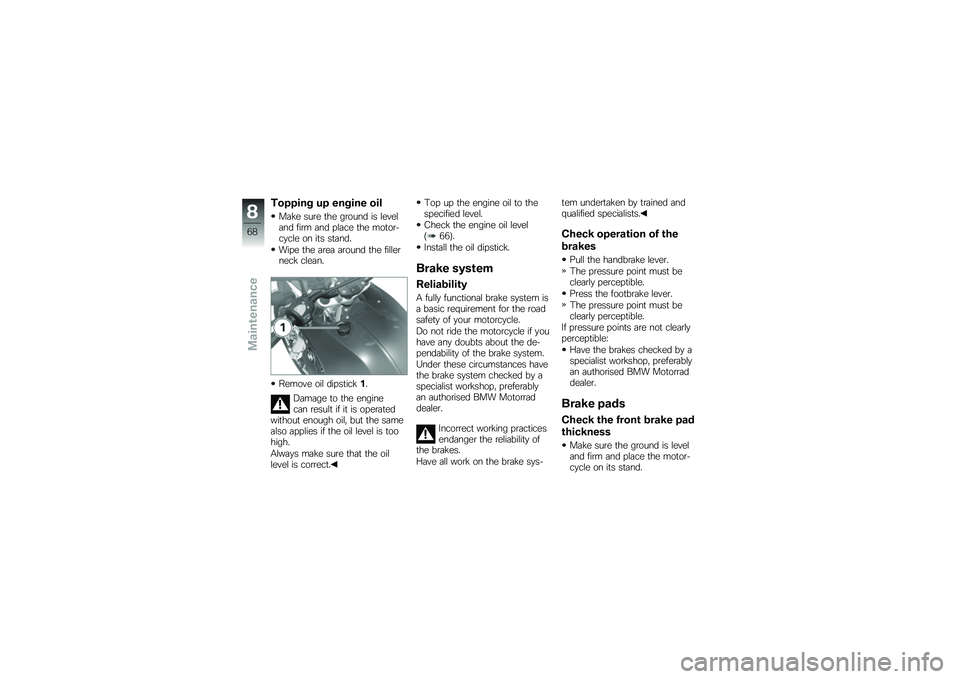Page 50 of 136

braking force can be transmittedwithout the wheel locking.
To optimise stopping distance,apply the front brakes rapidly andkeep on increasing the force youapply to the brake lever. Thismakes the best possible use ofthe dynamic increase in load atthe front wheel. Remember topull the clutch at the same time.In the "panic braking situations"that are trained so frequentlybraking force is applied as rap-idly as possible and with therider's full force applied to thebrake levers; under these circum-stances the dynamic shift in loaddistribution cannot keep pacewith the increase in decelerationand the tyres cannot transmit thefull braking force to the surfaceof the road. Under these circum-stances the front wheel can lockup.
BMW Motorrad ABS preventsthe front wheel from locking up.
Descending mountain
passes
There is a danger of thebrakes fading if you useonly the rear brakes when des-cending mountain passes. Underextreme conditions, the brakescould overheat and suffer severedamage.
Use both front and rear brakes,and make use of the engine'sbraking effect as well.
Wet and dirty brakes
Wetness and dirt on the brakediscs and the brake pads dimin-ish braking efficiency.
Delayed braking action or poorbraking efficiency must bereckoned with in the followingsituations:
Riding in the rain or throughpuddles of water.
After the motorcycle has beenwashed.
Riding on salted or grittedroads.
After work has been carried onthe brakes, due to traces of oilor grease.
Riding on dirt-covered surfacesor off-road.
Wetness and dirt result inpoor braking efficiency.
Apply the brakes lightly whileriding to remove wetness anddirt, or dismount and clean thebrakes.
Think ahead and brake in goodtime until full braking efficiency isrestored.
5
48
zRiding
Page 53 of 136
Risk of damaging compon-ents.
Take care not to trapcomponents such as brake linesor wires.
At the front, secure the strapsto the bottom fork bridge onboth sides.
At the rear, secure the strapsto the rear footrests on bothsides and tighten the straps.
Tighten all the straps uniformly;the motorcycle's suspensionshould be compressed astightly as possible front andrear.
5
51
zRiding
Page 55 of 136
Engineering details
Engineering details
Brake system with BMW Motorrad
ABS . . . . . . . . . . . . . . . . . . . . . . . . . . . . . . . . 54
6
53
zEngineering details
Page 56 of 136

Brake system with
BMW Motorrad ABS
How does ABS work?
The amount of braking force thatcan be transferred to the roaddepends on factors hat includethe coefficient of friction of theroad surface. Loose stones, iceand snow or a wet road all havemuch lower coefficients of fric-tion than a clean, dry asphalt sur-face. The lower the coefficientof friction, the longer the brakingdistance.
If the rider increases brakingpressure to the extent that brak-ing force exceeds the maxim-um transferrable limit, the wheelsstart to lock and the motorcycleloses its directional stability; a fallis imminent. Before this situationcan occur, ABS intervenes andadapts braking pressure to themaximum transferrable brakingforce, so the wheels continue
to turn and directional stabilityis maintained irrespective of thecondition of the road surface.
What are the effects of
surface irregularities?
Humps and surface irregularit-ies can cause the wheels to losecontact temporarily with the roadsurface; if this happens the brak-ing force that can be transmit-ted to the road can drop to zero.If the brakes are applied underthese circumstances the ABShas to reduce braking force toensure that directional stabilityis maintained when the wheelsregain contact with the road sur-face. At this instant the BMWMotorrad ABS must assume anextremely low coefficient of fric-tion, so that the wheels will con-tinue to rotate under all imagin-able circumstances, because thisis the precondition for ensuringdirectional stability. As soon as
is registers the actual circum-stances, the system reacts in-stantly and adjusts braking forceaccordingly to achieve optimumbraking.
Rear wheel lift
Even under severe braking, ahigh level of tyre grip can meanthat the front wheel does notlock up until very late, if at all.Consequently, ABS does not in-tervene until very late, if at all.Under these circumstances therear wheel can lift off the ground,and the outcome can be a high-siding situation in which the mo-torcycle can flip over.
Severe braking can causethe rear wheel to lift off theground.
When you brake, bear in mindthat ABS control cannot be reliedon in all circumstances to preventthe rear wheel from lifting clear ofthe ground.
6
54
zEngineering details
Page 57 of 136

What is the design
baseline for BMW
Motorrad ABS?
Within the limits imposed byphysics, BMW Motorrad ABS en-sures directional stability on anysurface. The system is not op-timised for special requirementsthat apply under extreme com-petitive situations off-road or onthe track.
Special situations
The speeds of the front and rearwheels are compared as onemeans of detecting a wheel'sincipient tendency to lock. If thesystem registers implausible val-ues for a lengthy period the ABSfunction is deactivated for safetyreasons and an ABS fault mes-sage is issued. Self-diagnos-is has to complete before faultmessages can be issued.
In addition to problems with theBMW Motorrad ABS, exceptional
riding conditions can lead to afault message being issued.Exceptional ridingconditions:
Riding for a lengthy period withthe front wheel lifted off theground (wheelie).
Rear wheel rotating with themotorcycle held stationary byapplying the front brake (burn-out).
Heating up with the motorcycleon the centre stand or an auxil-iary stand, engine idling or witha gear engaged.
Rear wheel locked for a lengthyperiod, for example while des-cending off-road.
If a fault message is issued onaccount of exceptional ridingconditions as outlined above, youcan reactivate the ABS functionby switching the ignition off andon again.
What significance
devolves on regular
maintenance?
Invariably, a technical sys-tem cannot perform beyondthe abilities dictated by its levelof maintenance.
In order to ensure that the BMWMotorrad ABS is always main-tained in optimum condition, itis essential for you to complystrictly with the specified inspec-tion intervals.
Reserves for safety
The potentially shorter brakingdistances which BMW MotorradABS permits must not be usedas an excuse for careless riding.ABS is primarily a means of en-suring a safety margin in genuineemergencies.
Take care when cornering. Whenyou apply the brakes on a corner,the motorcycle's weight and
6
55
zEngineering details
Page 67 of 136

Maintenance
Maintenance
Notes . . . . . . . . . . . . . . . . . . . . . . . . . . . . . . . 66
Toolkit . . . . . . . . . . . . . . . . . . . . . . . . . . . . . . 66
Engine oil . . . . . . . . . . . . . . . . . . . . . . . . . . . 66
Brake system . . . . . . . . . . . . . . . . . . . . . . . 68
Brake pads . . . . . . . . . . . . . . . . . . . . . . . . . 68
Brake fluid . . . . . . . . . . . . . . . . . . . . . . . . . . 70
Coolant . . . . . . . . . . . . . . . . . . . . . . . . . . . . . 72
Clutch . . . . . . . . . . . . . . . . . . . . . . . . . . . . . . 73
Tyres . . . . . . . . . . . . . . . . . . . . . . . . . . . . . . . 74
Rims . . . . . . . . . . . . . . . . . . . . . . . . . . . . . . . . 74
Chain . . . . . . . . . . . . . . . . . . . . . . . . . . . . . . . 75
Wheels . . . . . . . . . . . . . . . . . . . . . . . . . . . . . 76
BMW Motorrad front-wheel
stand . . . . . . . . . . . . . . . . . . . . . . . . . . . . . . . 83
Fuses . . . . . . . . . . . . . . . . . . . . . . . . . . . . . . . 84
Bulbs . . . . . . . . . . . . . . . . . . . . . . . . . . . . . . . 85
Air filter . . . . . . . . . . . . . . . . . . . . . . . . . . . . . 91
Jump starting . . . . . . . . . . . . . . . . . . . . . . . 92
Battery . . . . . . . . . . . . . . . . . . . . . . . . . . . . . . 93
Body panels . . . . . . . . . . . . . . . . . . . . . . . . 96
8
65
zMaintenance
Page 70 of 136

Topping up engine oil
Make sure the ground is leveland firm and place the motor-cycle on its stand.
Wipe the area around the fillerneck clean.
Remove oil dipstick1.
Damage to the enginecan result if it is operatedwithout enough oil, but the samealso applies if the oil level is toohigh.
Always make sure that the oillevel is correct.
Top up the engine oil to thespecified level.
Check the engine oil level(66).
Install the oil dipstick.
Brake system
Reliability
A fully functional brake system isa basic requirement for the roadsafety of your motorcycle.
Do not ride the motorcycle if youhave any doubts about the de-pendability of the brake system.
Under these circumstances havethe brake system checked by aspecialist workshop, preferablyan authorised BMW Motorraddealer.
Incorrect working practicesendanger the reliability ofthe brakes.
Have all work on the brake sys-
tem undertaken by trained andqualified specialists.
Check operation of the
brakes
Pull the handbrake lever.
The pressure point must beclearly perceptible.
Press the footbrake lever.
The pressure point must beclearly perceptible.
If pressure points are not clearlyperceptible:
Have the brakes checked by aspecialist workshop, preferablyan authorised BMW Motorraddealer.
Brake pads
Check the front brake pad
thickness
Make sure the ground is leveland firm and place the motor-cycle on its stand.
8
68
zMaintenance
Page 71 of 136
Visually inspect the brake padsto ascertain their thickness.Viewing direction: Between thespokes toward brake caliper1.
Brake disc thickness,front
min 1.0 mm (Friction padonly, without backingplate. The wear indicators(grooves) must be clearlyvisible.)
If the wear indicating marks areno longer clearly visible:
Brake pads worn past theminimum permissible thick-ness can cause a reduction inbraking efficiency and undercertain circumstances they can
cause damage to the brake sys-tem.
In order to ensure the dependab-ility of the brake system, do notpermit the brake pads to wearpast the minimum permissiblethickness.
Have the brake pads replacedby a specialist workshop,preferably an authorised BMWMotorrad dealer.
Checking rear brake pad
thickness
Make sure the ground is leveland firm and place the motor-cycle on its stand.
8
69
zMaintenance